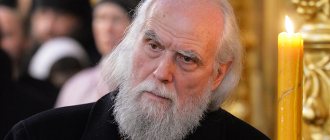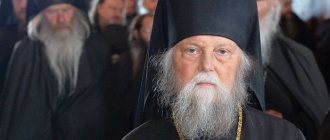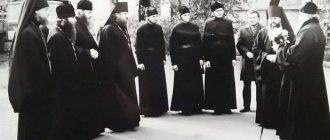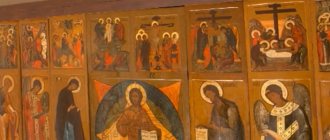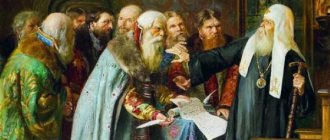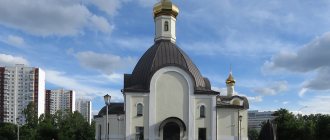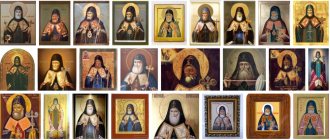Nun Gabriela (Parfenova)
In the libraries and archives of Moscow, St. Petersburg, Pskov and other regions today one can find many books published under the general editorship of the candidate of theology Archimandrite Hermogenes (in schema - Tikhon), confessor of the Nativity of the Virgin Mary of the Snetogorsk convent. At the same time, the real scale and significance of the scientific and publishing work of Archimandrite Hermogenes, unfortunately, is known to few. In this essay, which is an expression of our grateful memory of the deceased worker of the church field, we tried to talk about this side of his life and work, revealing, among other things, his invaluable contribution to research on the history of the Russian Orthodox Church of the past century.
...our correspondent Oleg Vasyunin spoke with Archimandrite Hermogenes (Eremeev).
– Father Hermogenes, you are the rector of several churches at once. Tell us about them, please.
– It would be more correct to say that I am the rector of a parish, which includes four churches. The main one is in the name of St. Seraphim of Sarov, the temple in honor of the Kazan-Ural Icon of the Mother of God is located on the second floor of the same building, the temple of St. Nicholas the Wonderworker is next door, and the temple of the martyr John the Warrior operates in Novoberezovsk.
– The last of them opened a temple in the name of St. Seraphim of Sarov. How did this happen?
– This is the most important event that we have been waiting for for a long time. But today the heart of this temple does not beat yet. I absolutely definitely associate the consecration of the throne with the fact that a living heart was beating inside the temple. We are looking forward to this event. The painting in the temple has been completed. Unfortunately, there are moments that I, as a rector, do not like.
For example, we rewrite almost all of the faces on the paintings. Let this be on the conscience of those unscrupulous people for whom it was important to earn money, and not to perform their work efficiently. Now we have to fix a lot of things.
This is if we talk about difficulties. Of course, there are more pleasant moments. We worked on this temple for a very long time. Its entire configurational and architectural part - arches, vaults - is very beautiful. The temple is an image of heaven on earth. And the feeling from the painting, from the painting, from the ornaments, from the iconostasis should be such that you have entered the Kingdom of Heaven.
I came to visit Father Seraphim for a while. I came to see how he lives there. I imagine it is early morning, the temple has not yet woken up, it is shrouded in a foggy haze. I think this image was a success.
December 8, 2012. Consecration of the temple in the name of St. Seraphim of Sarov
(Editor’s note: when this issue was being typed, the consecration of the temple in the name of St. Seraphim of Sarov took place. On December 8, 2012, it was consecrated by a host of bishops of the Russian Orthodox Church: Metropolitan Kirill of Yekaterinburg and Verkhoturye, Metropolitan Vikenty of Tashkent and Uzbekistan, Metropolitan Platon, who headed the Yekaterinburg See from 1980 to 1984).
Message from the news agency of the Ekaterinburg diocese dated July 22, 2003:
“A new image of the Most Holy Theotokos has been revealed in the Yekaterinburg diocese.
The story of this icon began on Christmas. A parishioner of the Yekaterinburg church in the name of St. Nicholas the Wonderworker had a dream in which she saw a shining image of the Virgin Mary in the snow. The Mother of God was dressed in white and was surrounded by snow crystals. On the right, above the icon, a green branch of a Ural spruce stretched, and on the left, a large snowflake fell on a snowdrift.
The woman who saw this dream turned to the Archbishop of Yekaterinburg and Verkhoturye Vincent with a request to paint an icon and received a blessing.
The parishioner told the rector of the church in the name of St. Nicholas the Wonderworker, Hegumen Hermogenes (Eremeev), about all this. And he, in turn, began searching for an artist who, according to the description, could depict the face of the Mother of God seen in a dream.
The icon was painted like this - with a fir branch in the right corner and a large crystal in the snow on the left. This image was called the Ural Icon of the Blessed Virgin Mary. It refers to the iconography of the Kazan image of the Mother of God. (...)
The new image was received with reverence not only by ordinary parishioners, but also by members of the Holy Synod, Metropolitan Juvenaly and Metropolitan Sergius, who visited the temple. Therefore, there is no doubt that the mercy of God has once again been shown to the people of the Urals.
And the celebration in honor of the Ural Icon of the Mother of God will be established at the moment of its appearance - on the third day of the Nativity of Christ.
Now all the documents necessary for this are being collected, which will be sent to the Holy Synod for consideration and making a final decision. You can see the icon in the St. Nicholas Church on Yasnaya Street in the regional center.”
– The temple in honor of the Kazan-Ural Icon of the Mother of God also opened not so long ago. Did the parish increase after this, did new people appear in connection with this?
– Not as many as we would like, but new parishioners are appearing. But the services became very good and comfortable. Over the past 10 years, we have become very tired of the crowding and stuffiness. Now we have much more space at our services, ventilation systems are working, and there is always fresh air. Nothing prevents those who come to the temple from praying.
– What’s interesting is that the new temple is being built over a long period of time, carefully, with maximum attention to all details. And the first temple in the name of St. Nicholas the Wonderworker was erected in just 18 days. How did it happen?
“We built that temple in one go. The desire and desire of a group of people coincided: mine and our benefactors, who were inspired to help me. We looked in the same direction, thought the same, acted in unison. And we succeeded. Since then we have not been able to part with our benefactors.
– This is probably one of the miracles. Even just organizing builders in such a time frame...
– Yes, that’s how everything was organized. The organization helped us is serious; the people working in it are disciplined. Good leaders led the construction.
“I know that the parish has a very strong choir. Tell us about it.
– Today I cannot say that I am completely satisfied with the choir. The main regent is currently on maternity leave - I hope that he will return to us soon. We will again begin to strengthen the composition of the choir and work on the quality of performance. After all, church singing is an integral part of worship. I always pay special attention to this.
– There are critical notes in your assessment. But, it seems to me, there are very few such parish choirs.
– Indeed, I believe that the parish should have a good choir. After all, you can find singers, regents, and psalm-readers, you just have to constantly do this. There wasn’t a day before a big service - Sunday or holiday - that I didn’t call the regent and ask what the lineup was today, how many tenors, how many sopranos. If someone is missing, of course I get upset. I ask you to call someone else, maybe the singers who once sang with us before, so that we have a full lineup. About 5 years ago we had 20 people in the choir, and at Easter 25 sang. Now the squad has been reduced to 16, but this is quite enough for us. I believe that if we have 4 people in a party - 4 sopranos, 4 altos, 4 tenors, 4 basses - this is a full choir, an ideal option.
But not all singers can attend every service. Everyone sings somewhere else - at the Opera House, in a symphony choir, in the Domestik choir, someone studies at the conservatory. The most important thing is that they are all musically educated and have a good base on which to work with them.
I feel very painful when one of the singers leaves the choir. First of all, this is incorrect in relation to the leader, the abbot. New choir members usually come with one or another shortcomings that need to be worked on for a long time: they detonate, that is, they do not sing clearly, do not know church voices, etc. With us they learn their voices, begin to sing more clearly, and sing their own voice. And it happens that as soon as they offer slightly more favorable conditions, the singer leaves. This is just a knife in the heart for me. I consider this a betrayal.
I understand that there are different circumstances. But Orthodox people take a blessing from the priest: “Father, would you give your blessing to move to such and such a church? I have this reason... I live close there... It’s convenient for me there...” - etc. We need to talk like a human being in such cases, and not leave in secret. I think that this issue should be raised at a general diocesan meeting. This is not the case when singers run from temple to temple. As soon as the lineup is assembled, as soon as it is sung, someone drops out. And that’s it - the work done has gone down the drain, you need to start over.
What is a choir? This is a living organism. It takes more than one month to get along with each other. Or maybe more than one year.
– Such a reverent attitude towards the choir, I think, is primarily due to the fact that you are a professional musician and vocalist. I would like to talk about this - how do you manage to combine the ministry of a priest with concert activities?
– I always say that my concerts are a continuation of the sermon. There is never enough time during a sermon to tell everything, to pour out your whole soul. Many singers say that it is impossible to express everything that is in your soul in words, in prose. And in the song this opportunity is presented a hundredfold. You can talk and talk and talk, but you still won’t say anything. And suddenly you sing some phrase - and you’ve said it all.
A new concert program is currently being prepared. It doesn't have a name yet. Maybe we’ll leave the old one: “I sing about you, Holy Rus'.” Or maybe it will be: “I sing to you, my Fatherland,” or something else, until we finally choose it.
They are still invited to give concerts in other dioceses and other regions. Such trips are not a cheap pleasure. Just the tickets to get to the place cost a lot of money. And if a whole team is traveling, then you understand... Another difficulty is gathering a team for the trip. As I already said, besides the choir, everyone else sings, works, and studies somewhere. That’s why sometimes we go out in small groups – me and the quartet. It happens, unfortunately, that you have to refuse invitations.
We are currently preparing for a trip to the Belgorod diocese. We are planning to give two concerts there. We have already given our consent, we are waiting for all the i’s to be dotted.
– Let’s return to parish life, to its traditions and features.
– We have a tradition of celebrating Easter, Christmas, and Maslenitsa together. We set up long tables and set them with tea, baked goods, buns, and other food. We invite all parishioners to enjoy the holiday together.
Church singing by parishioners during services is also traditional for our parish. Of course, not the entire service - at certain moments. For example: “My soul magnifies the Lord...”, “Bless the Lord, my soul...” and others. There is a small book with such chants in the church kiosk. Our parishioners really like it, and they sing well and with soul.
Another tradition is that once a year, during Holy Week, on Great Wednesday, we hold a general confession. This is due to the fact that Maundy Thursday is a special day; there are a lot of people who want to receive communion on this day. There can be up to 900 communicants - they come from all over the city, from other parishes. But there is physically no opportunity to take confession before this service - even if you take it all night, you still won’t have time. Therefore, on Great Wednesday we hold a general confession. This service contains a list of a huge variety of sins. Everyone has the opportunity to think about those sins that he usually does not remember, and to repent of them.
Our youth department has grown quite large, in a good way. Now it has more than 60 people. Of these, 20-30 people constantly come to classes. And there are more than 60 in the general list, which is nice.
The Orthodox St. Alexeevskaya school operates at the parish. The parish clergy cares for this school. We have an Orthodox sisterhood. There is also a parish pilgrimage department. We try to select routes that do not coincide with those offered by the diocesan department - we complement each other. We are developing these routes - for example: “The Path of Seraphim of Sarov”, “To the Holy Springs”, etc.
– You mentioned the youth department. What does he do?
– There are several areas of work. Gospel readings are held every Sunday. A chapter from the Gospel is read and carefully analyzed based on the interpretations of the holy fathers. The youth department is also involved in charitable activities. He stages holiday performances for Easter, Christmas, and other church holidays. Young people visit the elders' house and come there with gifts. Help people who need care. Our guys are known there and are very welcome.
At one time our youth even took up dancing. He hired a teacher-tutor for them. Now for some reason they stopped. Maybe they thought that dancing was something free. Although I don't think so. If the dances are pious, good, then why not. This is melodic music, beauty of movements. In general, our dancing did not go well. But there is a youth choir. They promise to sing the Liturgy, I hope to hear it soon.
In a word, we try to be correct. Time will tell how successful we are at this. In any case, we are climbing this steep slope. This is especially important in our difficult times, when young people have so many temptations. One of them is the Internet, which often causes youth to become intoxicated by drugs: once a person has immersed himself in it, few people return.
The youth organized a cinema club, where everyone especially willingly went. A film is watched (of course, without any vulgarities), then it is discussed. Club members analyze the actions of the heroes, discuss how it would be right for a Christian to act in a given situation. Is this or that action a sin? Why did the heroes do wrong? Maybe because they did not know the Laws of God, they lived only according to secular laws? This discussion captivates not only young people - and I find it interesting to watch the film and discuss the topic it sets.
– Tell us about the concerns and plans in the parish today.
“Soon we will open a small refectory where people will be offered lunches in the traditions of the Orthodox Church. It will be inexpensive, for a symbolic donation. In this way we will fulfill the dream of many of our parishioners. After all, it is natural that after a service, after standing on your feet for two or three hours, you want to eat. There has not been such an opportunity until now. If there is a secular cafe nearby, it is very expensive. Therefore, we are working to ensure that we will soon have an “Orthodox meal”.
Future plans include the reconstruction of St. Nicholas Church. We are planning to change the floors there and make them warmer. We want to plaster the gas boiler room. Then we plan to build another building for the youth department - just behind the altar of St. Nicholas Church.
Well, the usual work, the most ordinary parish life, goes on as usual.
– Father, among other things, you are the spiritual mentor of the State Traffic Inspectorate. This, you understand, arouses keen interest. Please tell us about it.
- This is an old story. I am fulfilling the obedience given to me by Bishop Vincent: I spiritually provide for the traffic police department of the Main Internal Affairs Directorate for the Sverdlovsk region. In fact, we have developed warm and friendly relations. I visit the department to congratulate the personnel on Orthodox holidays. I conduct sermons and talks, although not often, due to the busy work schedule of management personnel. But when we meet, these meetings can be very interesting. Once a whole company in full force visited the bell tower of our large temple. They still remember it with pleasure.
From the editor:
Key events for the Yekaterinburg diocese, in which Archimandrite Hermogenes (Eremeev) was a participant, remained outside the scope of this conversation. We found information about them in archival issues of the Orthodox Newspaper and other publications. It seems important to us to remember the times when the foundations were laid for what today seems unshakable and has always been.
August 1991. Archbishop Melchizedek (Lebedev), administrator of the Sverdlovsk and Kurgan diocese, blesses deacons Georgy Eremeev and Igor Romanenko to participate in the search for the place of destruction of the remains of the holy Royal Passion-Bearers, who were hidden by the authorities. The initiator of the search is the writer Vladimir Soloukhin, who arrived in the Urals as part of the First World Congress of Compatriots. The only landmark is the village of Koptyaki, mentioned in the materials of investigator N.A. Sokolov, who investigated the murder of the Royal Family in 1919. Only one local resident dares to violate the strict warning of the “competent authorities” and lead searchers to the tragic place (historical and topographical studies of 1991 - 1993 will confirm that the place was indicated correctly). Thus, in the summer of 1991, the Worship Cross was installed for the first time on Ganina Yama and a memorial service was served for the Royal Passion-Bearers and their faithful servants who had not yet been canonized at that time. 9 years later, His Holiness Patriarch Alexy II of Moscow and All Rus' visited this place and called it a living antimension, soaked in the burnt relics of saints. At the same time, a monastery was founded on Ganina Yama in the name of the Holy Royal Passion-Bearers.
In September 1991, another historical event took place for Yekaterinburg: the nickname given to the city after the terrorist-revolutionary Sverdlov was officially replaced by its real name - the Holy Great Martyr Catherine. This is preceded by the works of many people who are actively shaping public opinion in favor of restoring historical justice. We managed to find the text of an old article about. Hermogenes (at that time Deacon George), published on August 5, 1991 in one of the city newspapers:
“Forgive us, Saint Catherine!”
“Gradually we began to heal from many of the ills of our society. There are pressing issues not only about the return and restoration of churches, but also about the restoration of the historical names of cities, streets, and squares. At all times in Rus', after any wars that brought with them a lot of destruction and ruin, the first thing they did was restore churches, because the main thing was unshakable - the spirit of the people, their love for the Fatherland, whose name is Russia.
But we will talk about restoring the temple of our conscience and memory, and this is much more important than the construction of just a building. Returning our city its historical name Yekaterinburg is tantamount to restoring the temple. The name of the Holy Great Martyr Catherine, the heavenly patroness of our city, was desecrated.
There is a lot of controversy surrounding whose name the city bore. I can say with complete confidence that the city bore the name of St. Catherine, and not the Empress. Another thing is that the name of Empress Catherine played an important role in the name of the city. Proof that the city of Yekaterinburg had the name of a saint at its foundation was the majestic Catherine Cathedral, the consecration of which was the consecration of the city in honor and memory of the holy Great Martyr Catherine. And no letter from Tatishchev to Emperor Peter I can refute the fact of the accomplished consecration of the city.
Each person is given a name at birth, then at baptism this name is, as it were, spiritually fixed, and from the moment of baptism each person has his own guardian angel, i.e. the name of the saint or saint by whom he is named. This happens once and for a lifetime. The consecration of the temple in honor of the Holy Great Martyr Catherine was the baptism of our city, of which the saint became an angel.
Disrespect for your angel is a terrible sin. The desecration of the temple is terrible, but the desecration of the saints is monstrous. You can often talk about repentance, but not repent. We must realize that renaming the city of St. Catherine's visit to Sverdlovsk was nothing other than blasphemy towards the Holy Great Martyr Catherine. And the sooner the awareness of the sin we have committed comes to us, the sooner repentance will come. But without repentance there is no, and there will be no, salvation either in this age or in the future..."
And, if we talk about an active life position, high-profile publications and historical events, let us remember the movement for the canonization of the Royal Family and the struggle for the construction of the Church on the Blood, in which Fr. Hermogenes (Eremeev), and his poem, written in 2003 for the consecration of the Church-Monument on the Blood in the name of All Saints who shone in the Russian Land:
A special purpose house was once turned into rubbish. Here, on the site of the murder of the Tsar, the Penitent One was erected! And for every Russian heart it is of great importance - the Temple of Great Sorrow and Memory. Temple for a special purpose.
•In other rooms:•
Assistants to Archimandrite Hermogenes
Tamara Fedorovna Litvinova (monastically Seraphim; † 2015), the spiritual child of Archimandrite Hermogenes, provided great support in the research. Tamara Fedorovna, who survived the blockade and worked for many years in the archives of St. Petersburg, found important documents related to the Snetogorsk Monastery and provided us with a lot of valuable materials on the history of the Pskov diocese. All this helped a lot in the work of writing our books. She also made copies of five volumes of the Pskov Diocesan Gazette, including the 1917 edition, which was not in Pskov. This truly very valuable work turned out to be especially in demand when the question arose of creating an electronic version of the Pskov Diocesan Gazette.
The electronic version appeared thanks to the works of a real master and unmercenary Sergei Georgievich Semenov († 2015). He also translated into electronic format all our books published under the editorship of Archimandrite Hermogenes. On the initiative of Sergei Georgievich and the blessing of Father Hermogen, 24 volumes of copies of the Pskov Diocesan Gazette for the years 1894–1917 were printed and bound. Archimandrite Hermogenes asked to print several more copies of such sets. We transferred them to the State Archive of the Pskov Region, to the Pskov Diocese, to the Pskov Theological School and the Regional Scientific Library (along with the electronic version).
Our special gratitude goes to N.V. Kolomytseva († 2016), who provided us with invaluable assistance in creating a series of books about churches and monasteries of the Pskov region. After Nina Vladimirovna fell ill, we, unfortunately, had to stop publishing them.
For many years, an employee of the Pskov diocese, Lyudmila Alekseevna Gromova, helped us on various issues, especially in maintaining contact with various organizations, with readers of our books and with relatives of clergy.
In recent years, with the blessing of Archimandrite Hermogenes, we have been working on the publication of the “Bibliographical Directory of Priests and Church Officials of the Pskov Diocese of 1870–1917.” The first part of the directory was prepared on the basis of the administrative-geographical principle, and the second - in the form of an alphabetical list indicating graveyards. An electronic version of the directory was posted on the Internet. In 2013, as a manuscript, we sent the first version of the reference book entitled “Priests and clergymen of the Pskov diocese in 1870–1917” to archives and libraries. We are currently completing work on preparing for the publication of a “Bibliographical Directory”, created according to the alphabetical principle, which includes a lot of new information about repressed clergy that was not included in the “Pskov Synodik”.
The ascetic works of Archimandrite Hermogenes, his spiritual and educational activities and contribution to the study of the history of church life in the Pskov land have yet to be appreciated by future generations. We, who were honored to work under the leadership of this wise and kind shepherd, are infinitely grateful to God for this great mercy and offer prayers for the repose of our dear priest in the heavenly abodes. Eternal memory to Archimandrite Ermogen!
List of books published under the general editorship of Archimandrite Ermogen (Murtazov):
- Brochure “Our Father” with the Lord’s Prayer in 324 languages and dialects, dogmatic, doctrinal and moral explanation // Republished with the blessing of the confessor of the Nativity of the Mother of God of the Snetogorsk convent in Pskov, Archimandrite Ermogen (Murtazov). Pskov, 2009 – 145 p.
- A brief outline of the history of the Pskov diocese (1589–2010) / Compiled by N.V. Kolomytsev. Pskov, 2010. – 223 p.
- History of the Pskov diocese of the 9th–18th centuries. Historical and statistical collection of information. Vasily Smirechansky (archpriest). / Comp. and adapted text by E.F. Samuilov. Pskov, 2010. – 430 p.
- Pskov pilgrim (first issue). Temples and monasteries of the city of Pskov. / Comp. N.V. Kolomytseva (GAPO), nun Photinia (Parfenova). Pskov, 2009. – 224 p.
- Pskov pilgrim (second issue). Temples of the Pskov district of the Pskov province / Comp. N.V. Kolomytseva (GAPO), nun Photinia (Parfenova). Pskov, 2009. – 203 p.
- Pskov pilgrim (third issue). Temples and monasteries of Porkhov district of Pskov province / Comp. N.V. Kolomytseva (GAPO), nun Photinia (Parfenova). Pskov. 2011. – 246 p.
- Pskov pilgrim (issue four). Temples and monasteries of Velikoluksky district of Pskov province / Comp. N.V. Kolomytseva (GAPO), nun Photinia (Parfenova). Pskov, 2011. – 237 p.
- Pskov Synodik of those who suffered for the faith of Christ in the time of persecution, priests and clergy, monastics and laity of the Pskov diocese of the twentieth century. Moscow–Pskov, 2005. – 744 p.
- Chronicle of the Pskov Diocese (based on the pages of the Pskov Diocesan Gazette (1894–1917) / Compiled by nun Photinia (Parfenova). Pskov, 2009. – 212 p.
- ABC-Cyrillic / E.D. Popova. 2nd ed. // Under the leadership of Archimandrite Hermogenes. – St. Petersburg, 2021. – 260 p.
May 31, 2020
Used materials
- The Good Shepherd on the Niva of Christ, biography of Archimandrite Hermogenes (Kritsyn), on the website “ Orthodox Togliatti
”: https://pravoslavie-tlt.ru/shepherd-good-niva-Christova/
- https://blagovestsamara.rf/-public_page_9066
[1] Morev L.A., History of the Zadonsk Bogoroditsky Monastery
. Chapter XII: “Reviving former greatness” // Zadonsk Nativity of the Virgin Mary Monastery. Zadonsk 2010, p. 156.

